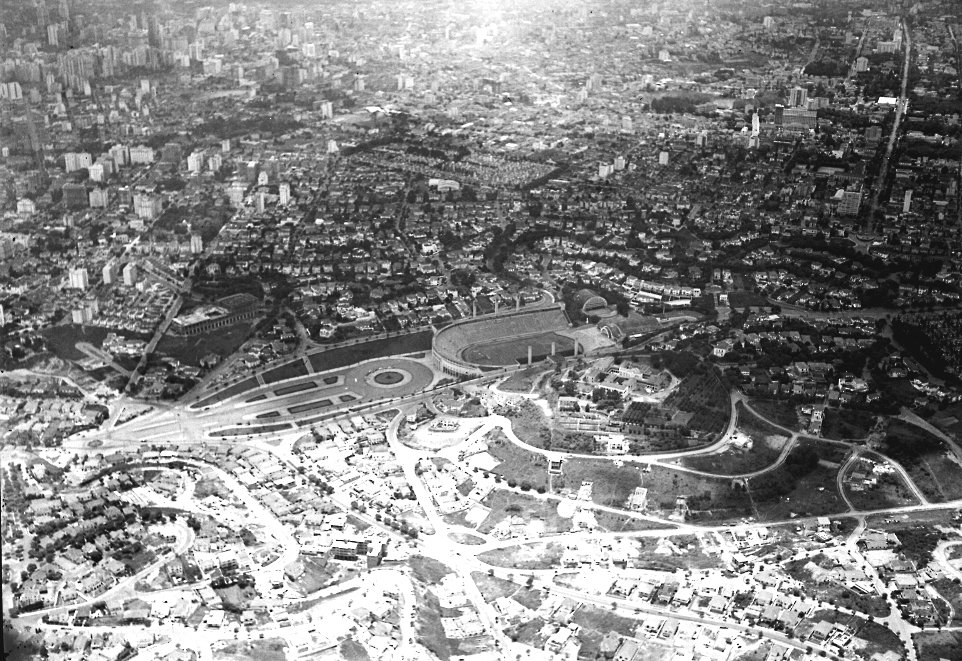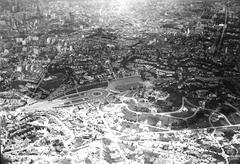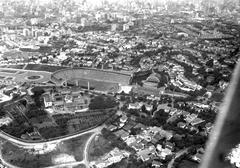
Antiga Unidade Sampaio Viana da Febem and Área Verde in São Paulo: Visiting Hours, Tickets, and Complete Guide
Date: 14/06/2025
Introduction
The Antiga Unidade Sampaio Viana da Febem and its Área Verde stand as a testament to São Paulo’s multifaceted history, blending social heritage, significant architecture, and vibrant urban green space. This guide delves into the site’s transformation from a 20th-century social institution to its current roles as a cultural hub and park, offering essential visitor information, practical tips, and a deep understanding of its enduring place in São Paulo’s urban landscape. Whether you’re a history enthusiast, architecture lover, or simply seeking a tranquil oasis in the city, this destination provides a unique window into São Paulo’s past and present.
(Prefeitura de São Paulo, Wikipedia)
Table of Contents
- Historical Overview
- Visiting Information
- Architectural and Environmental Features
- Cultural Significance and Community Impact
- Parque do Belém: Green Space and Amenities
- FAQ
- Summary and Visitor Tips
- References and Further Reading
Historical Overview
Early Origins and Institutional Development
The origins of the Antiga Unidade Sampaio Viana site trace back to the late 19th and early 20th centuries. Initially, the area served residential and charitable purposes, notably as a shelter for abandoned children under the Asilo dos Expostos, established by the Santa Casa de Misericórdia. Rapid urban growth in São Paulo and evolving social policies led to its expansion and transformation into a major institutional complex.
(Prefeitura de São Paulo, Wikipedia, iPatrimônio)
The FEBEM Era: Social Welfare and Controversy
By the mid-20th century, the site became part of the Fundação Estadual para o Bem-Estar do Menor (FEBEM), focused on juvenile rehabilitation. Designed by renowned architect Francisco de Paula Ramos de Azevedo, the complex blended modernist functionality with dignified aesthetics. However, during the 1980s and 1990s, the institution faced significant challenges, including overcrowding and allegations of mistreatment, mirroring broader systemic issues in Brazil’s juvenile justice system.
Transition and Regeneration
With the closure of FEBEM’s units and the transition to Fundação CASA in the early 2000s, the site’s future became the center of heritage and urban planning debates. Community groups and city officials advocated for preservation, resulting in its adaptive reuse: areas have become public parks, cultural centers, and educational spaces. The Belenzinho unit, for example, is now the Fábrica de Cultura Belém, a beacon for arts and community engagement.
(Fundação CASA, Vila Mariana Viva, Fábricas de Cultura, Folha de S.Paulo)
Heritage Protection
Municipal and state heritage agencies, such as CONDEPHAAT and CONPRESP, have recognized the site’s architectural and historical importance, ensuring the preservation of both the built environment and its extensive green area.
(Conpresp, Prefeitura de São Paulo - Heritage Documentation)
Visiting Information
Hours, Admission, and Accessibility
Antiga Unidade Sampaio Viana (Pacaembu/Vila Mariana)
- Regular Access: The main historical complex is generally closed to daily public access. Entry is permitted during special events or through scheduled group visits arranged with the Faculdade de Medicina da Universidade de São Paulo (FMUSP).
- Accessibility: Some historic areas have limited accessibility. Contact FMUSP or event organizers for arrangements.
- Admission: Access policies and any fees depend on the specific event.
Fábrica de Cultura Belém (Belenzinho)
- Opening Hours: Tuesday–Saturday: 9:00 AM–6:00 PM; Sunday: 10:00 AM–4:00 PM; Closed Mondays and public holidays.
- Admission: Free for all visitors.
- Accessibility: Fully accessible, with facilities for mobility and sensory impairments. Materials and tours available in Portuguese, Spanish, and English.
Parque do Belém
- Hours: Daily, 6:00 AM–6:00 PM.
- Admission: Free.
- Accessibility: Paved paths and accessible restrooms.
How to Get There & Nearby Attractions
- Metro Access: Vila Mariana and Belém stations (Line 3 – Red for Belenzinho and Parque do Belém; Line 2 – Green for Vila Mariana).
- Bus: Multiple lines connect the sites to central São Paulo.
- By Car: Limited street parking available; public transport is recommended due to traffic and parking constraints.
- Nearby Attractions: Ibirapuera Park, São Paulo Museum of Modern Art, Museu do Futebol, Pacaembu Stadium, and local cafés.
Events and Guided Tours
- Fábrica de Cultura Belém: Offers free workshops, performances, and regularly scheduled guided tours.
- Antiga Unidade Sampaio Viana (Pacaembu): Special events and heritage days occasionally open the site to the public.
- Parque do Belém: Community events, workshops, and cultural activities are periodically held; check the São Paulo municipal website for updates.
(Fábricas de Cultura, Prefeitura de São Paulo)
Architectural and Environmental Features
Architectural Heritage
- Design: Francisco de Paula Ramos de Azevedo’s design integrates high ceilings, large windows, and interconnected pavilions via a glass-enclosed aerial gallery.
- Key Spaces: Central administration, dormitories, chapel, nursery, service buildings.
- Construction: Brick masonry, stuccoed facades, ceramic or hardwood floors, and traditional clay-tiled roofs.
(iPatrimônio, Prefeitura de São Paulo - Heritage Documentation)
Environmental Value
- Área Verde: Over 216,000 m² of mature trees, lawns, and gardens—one of central São Paulo’s largest contiguous green spaces.
- Biodiversity: Home to native and exotic trees, birds, small mammals, and insects.
- Protection: Officially preserved as a municipal and state heritage site.
Cultural Significance and Community Impact
- Restorative Justice: The transformation from juvenile detention to cultural and educational centers represents a shift toward restorative justice and urban renewal.
- Community Programming: Fábrica de Cultura Belém delivers free arts, music, and educational workshops, emphasizing social inclusion, especially for youth, marginalized and immigrant communities, and people with disabilities.
- Preserving Memory: Through exhibitions, oral histories, and guided tours, the site acknowledges its complex past while fostering dialogue and empowerment.
(Fábricas de Cultura, Folha de S.Paulo, São Paulo Antiga)
Parque do Belém: Green Space and Amenities
- Recreation: Playgrounds, skate park, 1.5 km cycle path (free bicycles/tricycles, subject to availability), walking/jogging trails, picnic areas.
- Safety: Municipal guards and staff on site during peak hours. Park is safest during daylight.
- Facilities: Accessible restrooms, shaded seating, and open lawns.
- Access: Near Belém Metro Station; multiple bus lines serve Avenida Celso Garcia.
FAQ
Q: Are the sites free to visit?
A: General access to Fábrica de Cultura Belém and Parque do Belém is free. The historic Sampaio Viana complex is open only during special events.
Q: What are the opening hours?
A: Fábrica de Cultura Belém: Tue–Sat 9 AM–6 PM, Sun 10 AM–4 PM. Parque do Belém: Daily 6 AM–6 PM.
Q: Is the area accessible to people with disabilities?
A: Yes, both Fábrica de Cultura Belém and Parque do Belém are accessible; historic Sampaio Viana complex may have limited access.
Q: Are guided tours available?
A: Yes, Fábrica de Cultura Belém offers regular guided tours; the historic unit and park may offer tours during special events.
Q: How do I get there by public transport?
A: Both sites are easily accessible by metro and bus.
Summary and Visitor Tips
The Antiga Unidade Sampaio Viana da Febem and Área Verde exemplify São Paulo’s commitment to honoring its complex social past while embracing urban revitalization, heritage preservation, and cultural inclusion. Visitors can:
- Experience unique architecture and tranquil green spaces.
- Participate in free cultural and educational activities.
- Enjoy accessible amenities and easy metro access.
- Discover nearby attractions like Ibirapuera Park and the lively neighborhoods of Vila Mariana and Belenzinho.
Before visiting, check official websites or the Audiala app for the latest updates on hours, accessibility, and event schedules.
(Fábricas de Cultura, Prefeitura de São Paulo, VejaSP, Folha de S.Paulo)
References and Further Reading
- Prefeitura de São Paulo – City Cultural Heritage
- Governo do Estado de São Paulo
- Folha de S.Paulo
- Estadão
- Fundação CASA
- Vila Mariana Viva
- Conpresp – Heritage Preservation
- ArchDaily Brasil
- Revista Piauí
- Wikipedia – Antiga Unidade Sampaio Viana
- iPatrimônio
- Prefeitura de São Paulo – Heritage Documentation
- VejaSP
- ONU-Habitat Report on São Paulo Parks
- São Paulo Antiga
- Fábricas de Cultura
- Folha Agora
- Miss Tourist





































































































































































